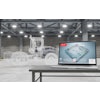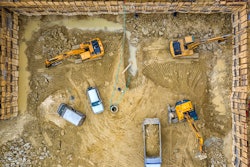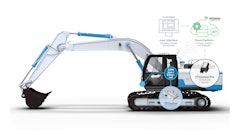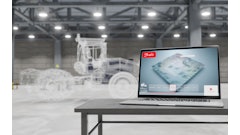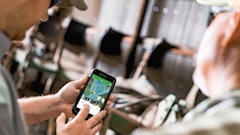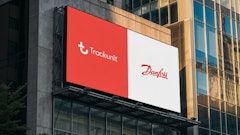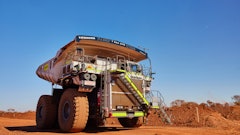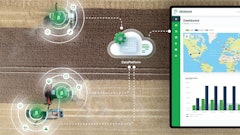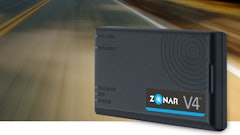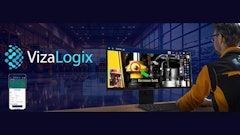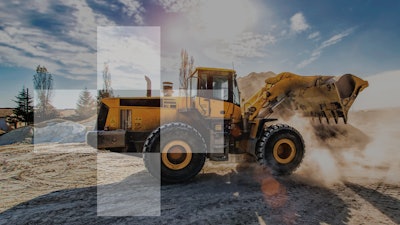
Telematics systems continue to play a pivotal role in heavy-duty equipment. As use of these systems has increased over the years, so too have their capabilities.
“Telematics as a technology has evolved significantly over the last 10 years,” says Pankaj Sharma, Vice President, Marketing and Product at NexTraq, a Michelin group company. “It's no [longer] just a location-based service like it used to be perceived in the past. It has evolved to be all about insights that make an impact on a fleet’s operations, whether it's productivity, safety, cost efficiency, compliance and a lot more.”
Retrieving data from a piece of equipment and making the most of that data continues to be an area in which telematics technology is evolving. Incorporation of more data analytics as well as artificial intelligence and vision technology, such as dash cams, are some of the ways Sharma says telematics systems are advancing to provide more information for vehicle and equipment owners.  Incorporation of vision technology such as dash cams into telematics systems are helping provide more information for vehicle and equipment owners.NexTraq
Incorporation of vision technology such as dash cams into telematics systems are helping provide more information for vehicle and equipment owners.NexTraq
Integration is becoming an important part of the equation, as well. “Understanding that no individual entity can provide all services, it’s very evident we need to be part of a big ecosystem to provide a higher impact for customers,” says Sharma.
Because of this, forming industry partnerships—whether with service providers or OEMs—will be vital to ensuring end-use customers get the features and information they need. Sharma notes that while NexTraq currently offers an aftermarket solution, it plans to work with OEMs as they play a critical role in ensuring the right equipment and vehicle insights are provided to end users.
“In addition to having a flexible portal and the ability to configure whatever data you want to collect, it’s also important to realize the level of telematics that every machine needs because not all machines are as complex; not all of them have complex electronics that need to be monitored and updated,” says Ivan Teplyakov, Business Development Manager for Connected Solutions at Danfoss Power Solutions.
For those wanting software updates, remote diagnostics or monitoring of complex electronics he says high level telematics systems with more connectivity are necessary. However, not every machine or customer needs this which is why Danfoss has made both the software and hardware used for its telematics systems flexible. “We offer a portfolio of three different devices. The customer can select the appropriate level of need for their particular machine as well as the appropriate level of cost.”
New technology improves data collection
Sharma says NexTraq provides fleet management services across multiple industries, including the heavy equipment industry. Those services are focused in four main areas—productivity and cost efficiency, safety, compliance and workforce management. “At the end of the day, all of our solutions and services are targeted toward these elements.”
The heavy equipment industry has a broad range of requirements including tracking assets, projects and workforce. As such, Sharma says the NexTraq solution brings together various elements into a single solution to help meet the industry’s range of needs. This provides a complete picture of how a business is operating and what changes need to possibly be made to work safer and more efficiently.
With the NexTraq solution, users can more easily track where and how their equipment is used. This can benefit rental companies which need to monitor equipment use and plan maintenance; it can also benefit equipment owners who want to ensure their employees are using the equipment in a safe and efficient manner.
Telematics provider Geotab recently introduced its GO9+ solution featuring Wi-Fi connectivity to help make it easier for fleets to track and monitor their equipment. Bluetooth beacons can be placed on tools and equipment which communicate with a Wi-Fi hub which then communicates with the Geotab technology.
Colin Sutherland, Executive Vice President, Sales & Marketing at Geotab, says when the company launched the new telematics solution customers said the biggest value was the amount of data generated to help with business operations. Because the device includes both cellular and Wi-Fi components, customers can potentially reduce their cellular data costs. Many equipment fleets have multiple portable devices and cellular plans which can become costly. Having a single solution capable of providing all of their data needs can help to reduce these costs.
Sutherland notes customers can set their rate plan to best meet their business needs. “We’re initially launching with a 2-gigabyte rate plan because we expect a lot of users to be dropping their expensive cellular plans and bringing it all through the GO9+ device,” he says.
 The addition of Wi-Fi connectivity in Geotab's new GO9+ expands tracking capabilities for fleets.Geotab
The addition of Wi-Fi connectivity in Geotab's new GO9+ expands tracking capabilities for fleets.Geotab
Customers have told Geotab they will be better able to track data consumption with this new device and operate more cost effectively. “It's all about operating costs in the field,” says Sutherland. “And in 2021 it's about staying lean, giving people productive tools, and eliminating wasted time. So you can find a tagged asset and you know where it’s used. Combining connected assets and devices enables an employee to work effectively in a really seamless way. And that's what excited us when we launched GO9+.”
While tracking a large piece of equipment will be beneficial, so too will the ability to track and monitor non-powered assets such as attachments and tools, even cargo in some cases.
Alex Romero, Product Manager for Software and Connected Solutions at Danfoss Power Solutions, says the telematics portfolio the company is launching keeps in mind the fact heavy equipment also continues evolving. “Not all machines have been equipped with enough intelligence to capture how the machine is performing in the field, and some of them are more evolved than others,” he explains. “[Some customers] may need more help from the intelligence that resides within the telematics gateway.”
As such, he says Danfoss has systems which are programmable and non-programmable.
Reliability and security of the information is integral, as well. Ensuring that is why Danfoss has chosen to engineer its own telematics system from the ground up. Romero says doing so provides more control over the type of protocols used for communicating information. The entire communication chain—other than the cellular network and infrastructure—is owned by Danfoss which enables it to provide customers with the data they need in a safe and secure manner.
The company is able to do this by ensuring its telematics gateways are compliant with the latest cybersecurity protocols and the right encryption to make sure the data is not exposed.
“A part of this evolving digital environment is data itself,” says Teplyakov. “It's about data ownership, and then data privacy. And by having full control over our system, we can deliver these services to our customers without including, any more than necessary, third parties which could bring an element of risk to the whole environment.”
 Danfoss' PLUS+1 connect provides an end-to-end data collection and transmission solution.Danfoss Power Solutions
Danfoss' PLUS+1 connect provides an end-to-end data collection and transmission solution.Danfoss Power Solutions
Telematics and the growth of connectivity
Over the past 20 years, Sutherland says diagnostic trouble codes (DTC) have moved beyond those which were engine or sometimes drivetrain focused to other components such as PTOs. More sensors are also being incorporated into components and systems to make them, and the overall piece of equipment, smarter. All of this is providing more information to help fleets maintain equipment and maximize uptime, he says.
However, it can be challenging to bring all of this information together, which is where telematics plays a role. Bringing all information and connected devices together to a common upload point—such as a telematics system—makes everything easier to manage.
The never-ending quest for productivity, which all of this information and maintenance planning looks to improve, has been a key driver for the increased use of digital technology in the heavy equipment industry says Romero.
“We’ve seen a large wave of adoption and willingness to adopt digital technology and specifically connectivity,” adds Teplyakov. More OEMs are doing so because the cost of entry is lower due to the rate at which technology has evolved. Many see the additional features which can be provided through digitalization as a requirement to compete in the market, as well.
Implementing connectivity and digitalization must be purposeful. Teplyakov says it should either solve a problem or increase reliability and productivity while reducing downtime. What that means for the off-highway equipment market can be very different. “The large OEMs understand what data needs to be collected and how they can show users the valuable information collected in order to drive these productivity improvements,” he says. “For the majority of the market, what that means could be very different.”
As such, he says every OEM customer needs to look at its own machine designs and what constitutes productivity benefits and reduced downtime. Based on that, it can then implement the right technology. “Because we cater to this market of small and medium OEMs, we need to have a very flexible platform that can be configured to these different needs,” says Teplyakov.
The user interface of Danfoss’ system is customizable with various levels of dashboards. Teplyakov says customers can configure which signals they want to monitor and at what frequency. There are also customizable reporting tools through which historical data can be viewed in a way the customer needs.
He says Danfoss consults with customers to determine what problems they’re looking to solve or where they want to make improvements. “It’s a learning process that together with the customer we go through every time.”
It is a growth process as well, he says. Telematics systems can provide some basic features such as machine monitoring. Adding connectivity can then further expand up these features while also making them faster and more automated.  For OEMs wanting software updates, remote diagnostics or monitoring of complex electronics, high level telematics systems with more connectivity are necessary.Danfoss Power Solutions
For OEMs wanting software updates, remote diagnostics or monitoring of complex electronics, high level telematics systems with more connectivity are necessary.Danfoss Power Solutions
“We always say that changing what you're already doing to implement connectivity usually will not lead to the kind of success you want. But rather, you should augment the processes that are already in place by adding these data insights into your machine,” says Teplyakov. “And then you can grow from there. As you're learning more about what the possibilities of connectivity are, then you start looking at more and more advanced features.”
When adding connectivity, he again notes the importance of an OEM understanding its machine and what signals would possibly provide deeper insights to aid end use customers.
Telematics play an important role in connectivity and the digital transformation of the heavy equipment industry, and is a key enabler component, says Romero. “To create an efficient machine network and deliver the promise of internet of machines, you need to connect them,” he says. “Connectivity technologies [like telematics] and pervasive expansion of wireless infrastructure has been key to this proliferation of connected machines.”
As machines continue to become more connected, it will be critical to also connect all of the different cloud platforms on which they run. Teplyakov says it will be necessary to have the cloud platforms communicate with one another to create machine networks which reach beyond a single IoT (Internet of Things) environment.
“That then will lead to connecting not just machines themselves but the actual worksites,” he says. Doing so would enable not just machines to be monitored but also the flow of various materials and resources. This would benefit a variety of industries including construction, agriculture, mining and others.
Proving the potential of EVs and alternative fuels
As alternative fuel and power sources become more prevalent in the heavy-duty vehicle and equipment markets, telematics technology will be able to provide insights into how they perform, as well.
Sutherland says there are several alternative fuel vehicles currently in the market which Geotab's telematics technology supports. It is able to provide not only the day-to-day operational health information but also the potential re-market value of a vehicle. “We’re proving to some companies that previously thought buying an alternative fuel vehicle was going to be really expensive to maintain in the fifth, sixth or seventh year, that actually the vehicle has about double the life of their combustion vehicle,” he says.
With electric and alternative fuel vehicles, customers will likely want to hang on to them for 1 million miles, not half a million miles as currently typical with combustion engine powered vehicles. “It's pretty impressive to see the distance the alternative fuel vehicles get, and how low per running cost per mile they actually will run,” says Sutherland.
As more alternatively powered vehicles and equipment enter the market, he says Geotab’s technology can help educate the industry about what is feasible with these new models. It can help a fleet see what assets could be electrified or operated on an alternative fuel, which Sutherland says is key to these new technologies’ uptake in the market. “It's giving people some benchmarks and trust that when they have to go to an alternative fuel…they will have the confidence to make that decision.”
The Geotab technology can also be used to provide insights to the OEMs of these alternatively powered vehicles to help them ensure their designs are meeting the needs of the market.  Geotab's new GO9+ includes cellular and Wi-Fi connectivity.Geotab
Geotab's new GO9+ includes cellular and Wi-Fi connectivity.Geotab
Sharma says electrification and automation will provide a big opportunity for telematics and fleet management solutions providers. Vehicles will be more connected and capable of providing more insights into how they are being used. “It enables us to provide a lot more insights to our customers in a very intuitive way,” he says.
There will also be a shift in safety and operations as these vehicles enter a fleet; more of the operations, such as maintenance, will become automated.
“There's a big change which is going to happen and I think fleet management services like ours will play a huge role, intermediating the gap between what they [fleets] currently have and how they're shifting,” says Sharma.
Going forward, every component and system is going to be natively connected from the beginning, he says. “As we move forward with the technology, every piece of equipment, every piece of a vehicle will have its own insights. And the more we learn, the more it will be required for someone to gather those insights and explain or give actionable next steps for a fleet manager or fleet owners to take. That's the way this evolution is going to take place and it's more about how you digest the information and present it to the customer so they can take the next steps,” concludes Sharma.



